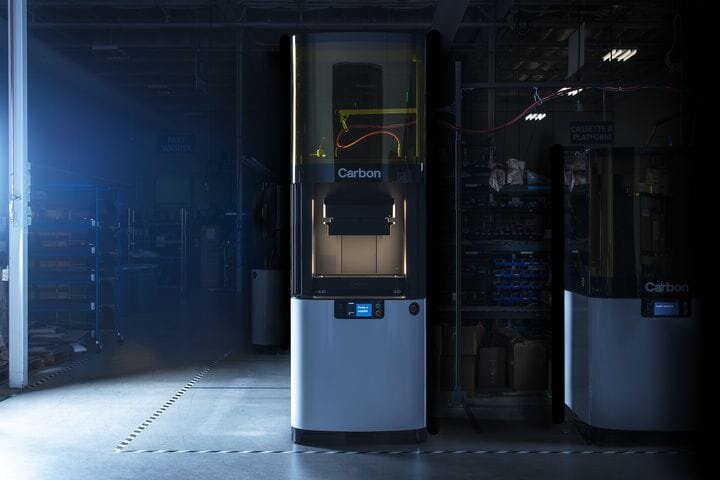![The Carbon L1 production 3D printer [Source: Carbon]](https://fabbaloo.com/wp-content/uploads/2020/05/image-asset_img_5eb08d01b0b14.jpg)
Carbon announced their largest 3D printer to date, the Carbon L1, is now shipping.
So far Carbon has released two flagship 3D printers, the M2 and the L1, which is now heading towards clients. The M2 was the first device marketed by Carbon, and has proven popular among manufacturers. The L1 is based on the same Digital Light Synthesis as used in the M2.
Digital Light Synthesis
Digital Light Synthesis is a 3D printing process that uses Carbon’s proprietary CLIP technique, in which the liquid photopolymer resin is separated from its storage tank by a microscopic layer of oxygen, which is allowed through a permeable layer. The oxygen inhibits the solidification process that normally occurs when the laser strikes the resin, but in other equipment causes the fresh layer to adhere to the resin tank. This causes big delays in 3D print jobs as the layer must be peeled off. Meanwhile, the oxygen layer prevents this from happening and thus Carbon’s 3D printers can print at near full speed constantly.
Digital Light Synthesis makes the Carbon machines ideal for production systems, since the print durations are low. Thus by running the machines continuously, a manufacturer would be able to produce reasonable quantities of products on a predictable basis.
Carbon L1 Production 3D Printer
![A row of Carbon L1 production 3D printers [Source: Carbon]](https://fabbaloo.com/wp-content/uploads/2020/05/image-asset_img_5eb08d01d3320.jpg)
The L1 differs from the earlier M2 device mostly in build volume. While the M2’s build volume is 189 x 118 x 326 mm, the L1 has a build volume said to be 5X that size. Exactly how much bigger we don’t actually know yet; Carbon will only say that the X-Y dimensions of the build volume are greater than 400 x 250 mm, which is indeed quite a bit larger than the M2.
This will allow manufacturers to produce larger-sized parts, or more possibly more smaller objects within a single build. Either way, it’s good for manufacturing.
The 3D printer is only one part of the solution provided by Carbon, who strive to create a complete, end-to-end solution for clients. It starts with Carbon’s software, which is designed to simplify the work a manufacturing client might undertake to develop a radically new product that leverages 3D printing technology advantages.
Carbon also provides a wide set of advanced materials for use in their devices. The L1 is ready to accept their rigid polyurethane, elastomeric polyurethane, epoxy and silicone materials, for example.
Carbon L1 Pricing
Carbon says the price of the L1 will be on a subscription basis, as are their other devices. To obtain an L1 3D printer, clients will subscribe at a rate of US$250,000 per year for a three year period.
That may seem like a lot of money, but the idea here is to run the machine 24/7 in production mode to manufacture end-use products for sale. The L1 is, in a sense, a money machine that makes products that gain more than the cost of producing them.
In other Carbon news, the company also announced that contract manufacturing giant Jabil has joined the Carbon Production Network, and now offers the ability to produce parts using Carbon’s technologies.
Via Carbon

